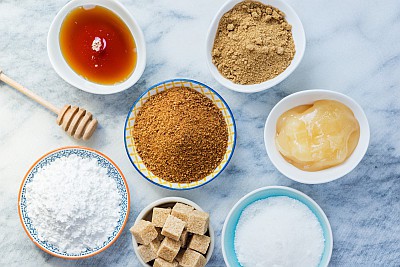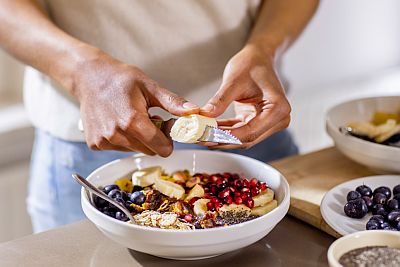Love sugar? You’re not alone! Many of us are prone to sugar cravings—and it can be all too easy to let the sweet stuff get the better of you.
With headlines constantly touting the perils of sugar, you may worry that all sweets could adversely impact your health. But how much is too much? What effects does excess sugar have on your health? And are there ways to add a little sweetness to your life without going cold turkey? Here we shed light on what the science says about sugar and how you can create a healthier relationship with sweets.
Sugar gets a bad rap—often rightly so—because we eat too much of it in the form of added sugars. Added sugars are sugars added during the processing of foods, foods packaged as sweeteners (such as table sugar), sugars from syrups and honey, and sugars from concentrated fruit or vegetable juices. The table below highlights the many other ways you may see sugar described on food labels.
You might think that some sweeteners are better for you than others, but don’t be confused by wholesome-sounding ingredients, like agave nectar or honey.
“While some sugars have a health ‘halo,’ the body processes all added sugars in the same way,” according to Dr. Kristina Petersen, an Assistant Professor in the Nutritional Sciences Department at Texas Tech University and member of the American Heart Association’s Nutrition Committee.
Data from the Centers for Disease Control (CDC) shows that most added sugars in the US diet come from sugary drinks, such as soft drinks, fruit drinks, sports, and energy drinks. Other major sources include desserts and sweet snacks, coffee and tea (sweetened before and after), candy, cereal, yogurt, and condiments.
Other Names for Sugar
Fruit juice concentrates
Molasses
Coconut sugar
Glucose
Raw sugar
Corn sweetener
High-fructose corn syrup
Sucrose
Agave nectar
Dextrose Maltose
Brown sugar
Evaporated cane juice
Malt syrup
Cane crystals
Fructose
Maple syrup
When considering sugar in your diet, it’s important to distinguish added sugars from those that are naturally occurring. These include sugars that are found in milk, fruits, and vegetables. They do not have the same negative effects because they are absorbed more slowly than added sugars and are part of nutrient-rich foods.
How Much Is Too Much Added Sugar?
Added sugars are so prevalent in our diet that it’s not surprising that most Americans are over-indulging. According to the CDC, the average American eats or drinks about 17 teaspoons of added sugar each day—roughly 270 calories. That translates to nearly 60 pounds of sugar per year, per person!
This is far above the recommended limit set by the American Heart Association, which suggests capping added sugar at 100 calories per day (6 teaspoons or 24 grams) for most adult women and 150 calories per day (9 teaspoons or 36 grams of sugar) for most men.

It doesn’t take much to meet or exceed the recommended sugar limit. For instance, a typical 20-ounce sports drink contains about 120 calories in added sugar. A 12-ounce can of regular soda has 125 calories of added sugar and a slice of chocolate cake can have almost 200 calories of added sugar.
The bottom line? A small amount of added sugar is fine for most healthy people. However, most of us are eating too much of it—and this can take a toll on our health.
Getting in Balance
Physiological, psychological, and environmental factors all play a role in our relationship with sugar. “Sugary foods can trigger the release of dopamine, our body’s ‘feel good’ chemical that can lead to more cravings,” says Dr. Petersen. In addition, stress, lack of sleep, and poor nutrition can play a role in making us want more sweets.
Cutting sugar from your diet too quickly or going cold turkey can result in withdrawal symptoms including headaches, fatigue, and mood swings. Taming your sweet tooth isn’t always easy, but it can be done.
Start by identifying the causes of your cravings. Common triggers include:
Blood Sugar Spikes. Frequently, sugar cravings arise from blood sugar spikes. “When you eat foods high in added sugar, your blood sugar spikes and your body releases insulin,” explains Dr. Petersen. If the insulin release lowers blood sugar too much, you may crave more sweets and find yourself on a sugar roller-coaster.
What Happens from Too Much Added Sugar?
Body Weight
While there’s no single cause of obesity, too much added sugar from foods and beverages can result in weight gain. According to Dr. Petersen, “sugar-rich foods and beverages are also typically low in nutrients that help to keep you full, like protein and fiber, making you more likely to eat more calories to feel satisfied.”
Heart Disease
Eating too much added sugar can hurt your heart. A major, 15-year study reported in the journal JAMA Internal Medicine found that people who consumed more than 25% of their daily calories as sugar were more than twice as likely to die from heart disease as those whose diets included less than 10% added sugar.
Tooth Decay
There’s abundant research showing a direct link between diets high in sweets and sugary beverages and tooth decay.
Type 2 Diabetes
Most studies to-date have not addressed the question of whether sugar is a unique cause of Type 2 diabetes. Although there is a clear relationship between obesity and type 2 diabetes, and researchers have found that high sugar diets are correlated with increases in body weight.
To get off the ride, you’ll need to eat more whole foods that are rich in protein and healthy fats. These nutrients keep blood sugar from spiking too much.
Timing is critical, too: Skipping meals can cause blood sugar to drop and it can be tempting to eat the first cookie or candy bar you see to bring it back up. Instead, eat meals and snacks on a regular basis so that blood sugar levels don’t drop precipitously throughout the day.
Stress and Sleep Deprivation. Stress and lack of sleep can undermine healthy habits and make cutting back on sugar more difficult. Stress releases cortisol in the body, which can result in elevated blood sugar and cravings. Lack of sleep is another major culprit making sugar more tempting. Studies show that sleep deprivation is linked to type 2 diabetes and obesity, and it also disrupts hormones that regulate hunger and satiety, making it harder to resist sweet and high fat foods.
Tips to Reduce Added Sugar in Your Diet
Once you’ve identified lifestyle habits like skipping meals, lack of sleep and stress, it will be easier to make successful changes to reduce added sugar. Here are tips to create a healthy balance with sugar.
Make Savvy Sweet Swaps
One way to satisfy your sweet tooth is by using fruits, herbs, and spices. Naturally sweet foods include watermelon, bananas, apples, grapes, dates, and prunes. Berries are a great choice; their sugars are released more slowly than other fruits. Spice up meals and snacks with vanilla and cinnamon. Boosting flavor helps you feel satisfied, and cinnamon has been shown to reduce sweet cravings by helping to manage insulin sensitivity.

Sip Smarter
Since sugar sweetened beverages constitute the largest source of added sugars in the American diet, one of the best ways to slash your intake is by eliminating or reducing sugar-rich sodas, coffees, teas, and sports drinks. Instead, opt for beverages that are unsweetened, lightly sweetened, or made with zero calorie sweeteners.
Become a Sugar Sleuth
When buying packaged foods, always read the nutrition facts panel and ingredients. In recent years, identifying the amount of added sugar in packaged foods has become a little easier, thanks to requirements to show the amount in grams and total percentage of calories from added sugars, based on 2000-calorie diet. Check the ingredients, too. They’re listed in order of quantity in the product, so if any type of added sugar is among the first few ingredients, you’ll want to limit the amount you eat. Nutrition information is also available upon request for most of the foods ordered in restaurants.
Plan Healthy Meals and Snacks in Advance
Keep your blood sugar from plummeting by knowing what you’re going to eat for the day ahead. Shopping ahead of time and having a general sense of main meals and snacks will prevent you from diving for a giant piece of cake when you get hungry. Make sure your meals and snacks contain a good balance of protein, fat, and complex carbohydrates. For instance, a dinner of baked cod or chicken with a side of asparagus drizzled with olive oil and 1/2 cup of brown rice provides a good balance.For snacks, make sure you have a mix of protein and fiber to keep you satisfied. Great snacks to keep on hand include plain, low fat (or nonfat) Greek yogurt and berries, a handful of nuts and an apple, a slice of whole wheat bread topped with avocado, and hummus with sliced veggies.
Aim for Moderation not Depravation
“Trying to cut all added sugars isn’t necessary or practical for most people, and it often backfires,” warns Dr. Petersen. Instead, she says, enjoy a cookie, slice of pie, or scoop of ice cream from time to time. Keep portion sizes moderate and make sweet treats occasional, not part of every meal or snack. “Be mindful of what you eat and take time to savor your sweet calories,” advises Dr. Petersen. “We get the most enjoyment from the first few bites, so having a super-sized dessert isn’t necessary to satisfy a sweet craving.”
Note: Since everyone’s health history and nutritional needs are so different, please make sure that you talk with your doctor and a registered dietitian to get advice about the diet and exercise plan that‘s right for you.

